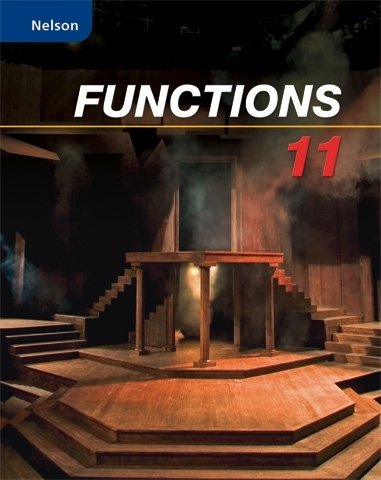
Nelson Functions 11
1st Edition
ISBN: 9780176332037
Textbook solutions
All Solutions
Section 4-5: Exploring the Properties of Exponential Functions
Exercise 1
Step 1
1 of 5
a) Since the second differences are constant, the function is $bold{quadratic}$
begin{table}[]
defarraystretch{1.5}%
begin{tabular}{|l|l|l|l|}
hline
$x$ & $y$ & First differences & Second Differences \ hline
$-4$ & $5$ & & \ hline
$-3$ & $8$ & $8-5=3$ & \ hline
$-2$ & $13$ & $13-8=5$ & $5-3=2$ \ hline
$-1$ & $20$ & $20-13=7$ & $7-5=2$ \ hline
$0$ & 29 & $29-20=9$ & $9-7=2$ \ hline
$1$ & 40 & $40-20=11$ & $11-9=2$ \ hline
end{tabular}
end{table}
begin{table}[]
defarraystretch{1.5}%
begin{tabular}{|l|l|l|l|}
hline
$x$ & $y$ & First differences & Second Differences \ hline
$-4$ & $5$ & & \ hline
$-3$ & $8$ & $8-5=3$ & \ hline
$-2$ & $13$ & $13-8=5$ & $5-3=2$ \ hline
$-1$ & $20$ & $20-13=7$ & $7-5=2$ \ hline
$0$ & 29 & $29-20=9$ & $9-7=2$ \ hline
$1$ & 40 & $40-20=11$ & $11-9=2$ \ hline
end{tabular}
end{table}
Step 2
2 of 5
begin{table}[]
defarraystretch{1.5}%
begin{tabular}{|l|l|l|l|}
hline
$x$ & $y$ & First differences & Second Differences \ hline
$-5$ & $32$ & & \ hline
$-4$ & $16$ & $32-16=16$ & \ hline
$-3$ & $8$ & $16-8=8$ & $16-8=8$ \ hline
$-2$ & $4$ & $8-4=4$ & $8-4=4$ \ hline
$-1$ & 2 & $4-2=2$ & $4-2=2$ \ hline
$0$ & 1 & $2-1=1$ & $2-1=1$ \ hline
end{tabular}
end{table}
b) Since the first and second differences are NOT constant, the function is neither linear nor quadratic. However, notice that $dfrac{8}{4}=dfrac{4}{2}=dfrac{2}{1}$. Since the differences have constant ratio, the function is $bold{exponential}$.\\
defarraystretch{1.5}%
begin{tabular}{|l|l|l|l|}
hline
$x$ & $y$ & First differences & Second Differences \ hline
$-5$ & $32$ & & \ hline
$-4$ & $16$ & $32-16=16$ & \ hline
$-3$ & $8$ & $16-8=8$ & $16-8=8$ \ hline
$-2$ & $4$ & $8-4=4$ & $8-4=4$ \ hline
$-1$ & 2 & $4-2=2$ & $4-2=2$ \ hline
$0$ & 1 & $2-1=1$ & $2-1=1$ \ hline
end{tabular}
end{table}
b) Since the first and second differences are NOT constant, the function is neither linear nor quadratic. However, notice that $dfrac{8}{4}=dfrac{4}{2}=dfrac{2}{1}$. Since the differences have constant ratio, the function is $bold{exponential}$.\\
Step 3
3 of 5
begin{table}[]
defarraystretch{1.5}%
begin{tabular}{|l|l|l|l|}
hline
$x$ & $y$ & First differences & Second Differences \ hline
$-2$ & $-2.75$ & & \ hline
$0$ & $-2$ & $-2-(-2.75)=0.75$ & \ hline
$2$ & $1$ & $1-(-2)=3$ & $3-0.75=2.75$ \ hline
$4$ & $13$ & $13-1=12$ & $12-3=9$ \ hline
$6$ & 61 & $61-13=48$ & $48-12=36$ \ hline
$8$ & 253 & $253-61=192$ & $192-48=144$ \ hline
end{tabular}
end{table}
c) Since the first and second differences are NOT constant, the function is neither linear nor quadratic. However, notice that $dfrac{9}{2.75}=dfrac{36}{9}=dfrac{144}{36}=4$. Since the differences have constant ratio, the function is $bold{exponential}$.\\
defarraystretch{1.5}%
begin{tabular}{|l|l|l|l|}
hline
$x$ & $y$ & First differences & Second Differences \ hline
$-2$ & $-2.75$ & & \ hline
$0$ & $-2$ & $-2-(-2.75)=0.75$ & \ hline
$2$ & $1$ & $1-(-2)=3$ & $3-0.75=2.75$ \ hline
$4$ & $13$ & $13-1=12$ & $12-3=9$ \ hline
$6$ & 61 & $61-13=48$ & $48-12=36$ \ hline
$8$ & 253 & $253-61=192$ & $192-48=144$ \ hline
end{tabular}
end{table}
c) Since the first and second differences are NOT constant, the function is neither linear nor quadratic. However, notice that $dfrac{9}{2.75}=dfrac{36}{9}=dfrac{144}{36}=4$. Since the differences have constant ratio, the function is $bold{exponential}$.\\
Step 4
4 of 5
d) Since the first differences are constant, the function is $bold{linear}$
begin{table}[]
defarraystretch{1.5}%
begin{tabular}{|l|l|l|l|}
hline
$x$ & $y$ & First differences & Second Differences \ hline
$0.5$ & $0.9$ & & \ hline
$0.75$ & $1.1$ & $1.1-0.9=0.2$ & \ hline
$1$ & $1.3$ & $1.3-1.1=0.2$ & $0.2-0.2=0$ \ hline
$1.25$ & $1.5$ & $1.5-1.3=0.2$ &$0.2-0.2=0$ \ hline
$1.5$ & 1.7 & $1.7-1.5=0.2$ & $0.2-0.2=0$ \ hline
$1.75$ & 1.9 & $1.9-1.7=0.2$ & $0.2-0.2=0$ \ hline
end{tabular}
end{table}
begin{table}[]
defarraystretch{1.5}%
begin{tabular}{|l|l|l|l|}
hline
$x$ & $y$ & First differences & Second Differences \ hline
$0.5$ & $0.9$ & & \ hline
$0.75$ & $1.1$ & $1.1-0.9=0.2$ & \ hline
$1$ & $1.3$ & $1.3-1.1=0.2$ & $0.2-0.2=0$ \ hline
$1.25$ & $1.5$ & $1.5-1.3=0.2$ &$0.2-0.2=0$ \ hline
$1.5$ & 1.7 & $1.7-1.5=0.2$ & $0.2-0.2=0$ \ hline
$1.75$ & 1.9 & $1.9-1.7=0.2$ & $0.2-0.2=0$ \ hline
end{tabular}
end{table}
Result
5 of 5
a) quadratic
b) exponential
c) exponential
d) linear
Exercise 2
Step 1
1 of 3
$bold{Concept:}$ The graph of exponential functions increases or decreases at a fast rate, linear functions are straight lines, while quadratic functions are parabolic and symmetric.
Step 2
2 of 3
$bold{Solution}$ Apply the concept above by inspecting the given graphs.
a) This one decreases rapidly, so it must be exponential.
b) This one increases rapidly, so it must be exponential.
c) This one is a straight line so it must linear.
d) This one is parabolic so it must be quadratic.
Result
3 of 3
a) exponential
b) exponential
c) linear
d) quadratic
unlock

